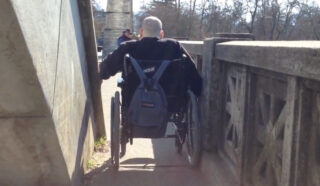
(Screengrab from a video made for HASL Center for Independent Living.)
The ODOT Files is a collection of stories that illustrate how the Oregon Department of Transportation prioritizes auto and trucks users at the expense of everyone — and everything — else.
The Oregon Deparment of Transportation is spending $5.3 million to update and make seismic retrofits to the historic Caveman Bridge in Grants Pass. The project goal is to bring the bridge back to is “Depression era beauty” by repairing cracks, broken concrete, exposed rebar, and delamination of the deck. But for people who use the bridge sidewalk — especially those who use wheelchairs and other vehicles — there’s nothing beautiful about narrow pinch points.
And there was nothing in the plans to widen them until the agency’s hand was forced.
The Caveman Bridge is the main gateway to the Oregon Coast via Redwood Highway (Route 199). It crosses the mighty Rogue River and is a key connection between main street and destinations southwest of downtown. It’s also one of only three bridges in the entire city that crosses the river.
The bridge is admired for its beauty, but for sidewalk users it’s also known as a tight squeeze. Especially for people who use wheelchairs. The narrowest distance between the concrete rail and the swooping arches that spring from the sidewalk is about 31 inches. That’s less than three feet. A standard wheelchair is about 26 inches wide — which leaves just a few inches for hands and arms.
Advertisement
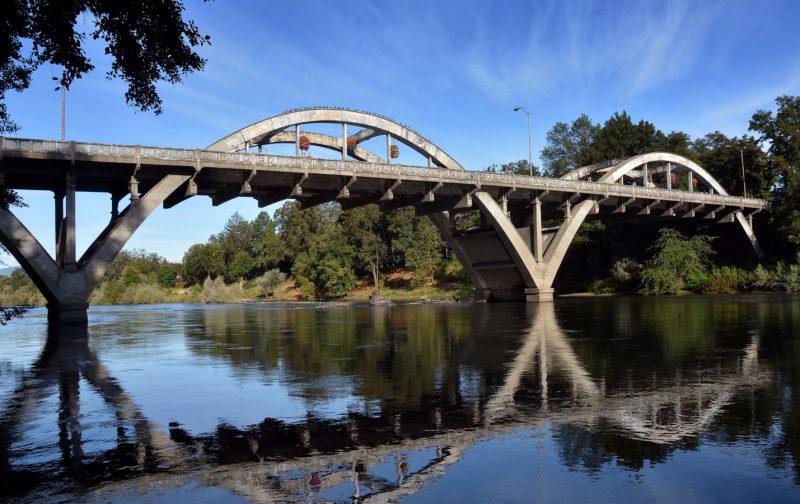
When ODOT began this project in 2016, they considered widening the sidewalk. Local advocates, the Grants Pass City Council, and Disability Rights Oregon all urged ODOT to widen the sidewalk. DRO said a wider sidewalk was necessary, “so that people who use wheelchairs no longer had to endure squeezing through the walkway and risk scraping their knuckles or bumping their elbows.”
But ODOT felt differently. Their project team assessed three options and decided none of them would work after they, “Were determined to have an adverse effect on the historic bridge.”
DRO then continued to push for a wider sidewalk within the constraints of the existing design. Months later, ODOT decided to cut off a decorative flange from the arches that would widen the pinch-point by three inches.
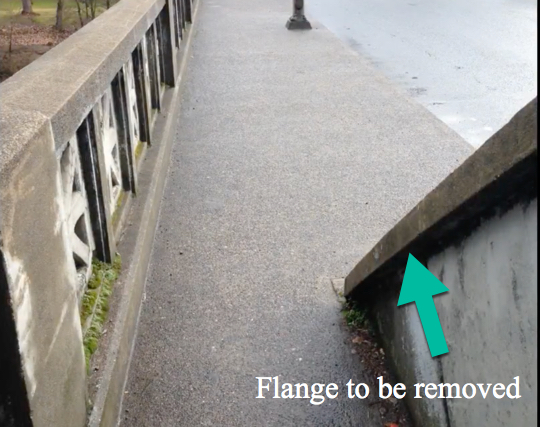
“The city was asking for more, and the disabled community was asking for more,” ODOT spokesperson Gary Leaming told the Grants Pass Daily Courier. “Three inches doesn’t seem like a lot, but it’s going to make a difference.”
Now DRO, an organization that has already won a major lawsuit against ODOT for the agency’s failure to comply with ADA standards on their roads (a recent survey as part of that settlement found that 97 percent of 26,000 curb ramps analyzed weren’t ADA-compliant) is pushing ODOT to review all projects that have requested ADA design exceptions.
“We think the agency should review all projects that were granted a historical exception to the ADA, whether ongoing or completed, and put in place a more rigorous process before granting future exceptions,” DRO wrote in a blog post on March 7th.
Why am I sharing this post on BikePortland?
This is just another illustration of how ODOT gives short shrift to everyone who uses their roads while not inside a car or a truck (my dad also lives a few miles from this bridge and might use a wheelchair himself someday).
— Jonathan Maus: (503) 706-8804, @jonathan_maus on Twitter and jonathan@bikeportland.org
Never miss a story. Sign-up for the daily BP Headlines email.
BikePortland needs your support.


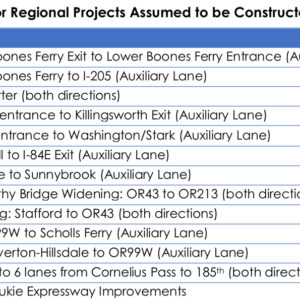

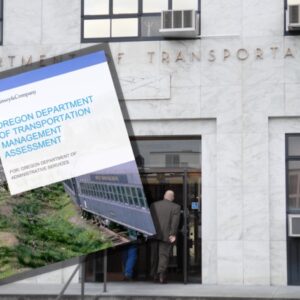
All this fuss over three inches. I can’t believe how blind and short-sighted ODOT can be.
And therr really isn’t a “standard” wheelchair. A lot of models come in different widths for different-sized people. This change will increase the number of users that will be accommodated, but will not accommodate everyone. (I don’t know the figures on that) Another option would be to remove a traffic lane and widen the sidewalk inside the arches.
Thanks Doug.
And I didn’t mention it in the story, but the situation on the St. Johns Bridge is similar. Several years ago ODOT did a seismic retrofit to that historic bridge and dragged their feet on making substantive changes to the sidewalk. They ultimately added some space to the belvederes, but it was very minimal. And as everyone knows the conditions on that sidewalk are absolutely horrible. And of course ODOT infamously denied all requests to change the lane configuration to add dedicated bicycle access — despite studies and many reasonable and smart people assuring them the sky wouldn’t fall if they did it.
An acquaintance works at a local hospital. She assures me that as Americans continue to get more obese wheelchairs are getting wider and wider. Add in the fact that obese people are likely to have mobility issues earlier in life, and we really need to seriously consider design changes to accommodate these folks. Shame on ODOT.
This is all about money, which is the same reason ODOT doesn’t want to retrofit or replace the Flint Ave. bridge as part of the proposed I-5 widening through the Rose Quarter.
Hi Buzz,
In some ways I agree. ODOT feels their projects “can’t afford” changes like this. But to say it’s all about money is a cop-out IMO. We have to demand that our DOT scopes their projects with accessibility for all users built in. It’s the ODOT culture that sees nothing but cars and trucks that leads to project plans that leave wheelchair users, bicycle riders, walkers, and others, left out of the picture (or underserved). And how is ODOT culture formed? From legislators who set policy but have no transportation acumen and who are also very biased toward driving. And then there’s the OTC which has so far failed to oversee ODOT effectively on many fronts. And ultimately it’s the Governor’s office who for some reason is completely blind to transportation policy and ODOT’s missteps.
Oregon can absolutely afford to do the right things on state-controlled streets. And as you know, the myopia is so infuriating because by favoring only cars and trucks we end up spending sooo much more in the long run.
Interesting.
The bridge in Grant’s Pass is a Conde McCullough structure. Saint John’s is by David Steinman. They are this country’s two premier bridge engineers.
Both bridges date from the 1930s. It McCullough and Steinman were designing today you can be sure ADA would be highly respected.
Good point. Just as I’d like to think that designers of today would welcome future changes to their designs in order to accommodate needs of future users.
ODOT is the same agency satisfied with building bridges, then blowing them up. And not one person is canned for it. And they are doubly satisfied when they build a cheapy asphalt bypass around a guard rail (you know, for cars).
amazing
With the likely reopening of the scope of this design “if” it is taken to court…is there any opportunity to built a multimodal / ADA pathway suspended below the existing structure – resting on the existing piers – and oriented through the archways…assuming they are high enough for passage? This could be a very airy and see-thru type of a structure so as to not distract from the heritage bridge.
[I assume there would to be much if any conflict with river navigation…I have never walked or biked or floated past this structure…so I am just taking a design guess.]
isn’t ADA law 36 inches absolute minimum?
If so, 34 inches is still not enough.
I think 36″ is the minimum for an accessible route, but it can be reduced at points. For instance, door openings must be 36″ min., but that assumes the actual opening will be reduced to 34″ by the door being open 90 degrees. This is from memory without checking, and I’m no expert, so could be wrong.
My guess is that most people can manage 34″ clearance for short distances, although of course 36″ (or more) would be better. It’d be great to hear from someone who actually knows from experience.
Oregon state highway department doing what they do best.
Cutting down trees?
#odotwarontrees
In Vancouver they took a heritage bridge and made one end of it wider by two travel lane widths all while keeping the same look of the old heritage style railings. It can be done technically. Political will is another thing though. Clearly the message is that these people in wheelchairs should just arrange to have someone drive them across.
Here’s a nifty video of the bridge.
https://youtu.be/Lm9UiMQz-s0
One thing that may help put costs for accessibility into context–the building code requires that alteration projects spend up to 25% of the construction budget to remove barriers to accessibility. For example, someone doing a $50k office alteration would have to spend up to $12.5k to widen doors, make a restroom accessible, etc. but wouldn’t need to add an elevator (if on an upper floor) because that would exceed the 25% budget.
Some construction costs (such as for seismic upgrades, I believe) don’t count towards the total cost from which the 25% is calculated. Again this is from memory, not guaranteed to be correct, but it’s at least generally correct.
The point is that someone doing a $5 million alteration to a building would be expected (actually legally required) to spend over $1 million to improve accessibility. If the building is historic, there’s some leeway allowed to avoid damage to the historic integrity, but not lots.
I don’t know the costs to widen the clearances for this project, but my guess is ODOT’s idea of what’s a reasonable cost to achieve accessibility for pedestrians n this bridge may be a lot less than what people altering buildings are required to deal with routinely.
Offering to spend someone else’s money is easy, and doesn’t make you a good person.
Well, that’s hostile. Not to mention false, since ODOT’s money is public money, so it’s my money as much as anyone’s.
It’s also shortsighted. During a major renovation is the perfect time to fix the clearance. Much better to do it now, than to push it into the future when it will cost more, with nobody getting the benefit until then.
Finally, because it’s public money, why would it make sense that only SOME of the people who pay get to use the sidewalk? People using wheelchairs pay taxes, including gas taxes. So do parents with strollers, or bikes with carts. Maybe you can say they can leave their strollers or carts home, then they can use the walk just like anyone else, but you can’t tell someone to leave their wheelchair home.
It seems relatively inexpensive to remove a portion of the “lip” and gain 3 inches of clearance for not just wheelchairs but also cargo bikes. What is (was) the argument for not doing this?
I think ODOT’s main argument was that the solution didn’t involve removing any trees.
#odotwarontrees
Just there is an Americans with Disabilities act, there is also a Federal Historic Preservation act. The preservation act requires, among other things, “The historic character of a property will be retained and preserved. The replacement of intact or repairable historic materials or alteration of features, spaces, and spatial relationships that characterize a property will be avoided.” Historic preservation activists have often interpreted “avoided” to mean “no change”. In this case ODOT must convince the historic preservation folks that the 3 inches here makes all the difference and is not an impact to the historic preservation, if they cannot then any federal funding on the project could be pulled. The lawsuit, and it’s findings, elevate the need for ADA access above the need for historic preservation and ODOT is acting accordingly. Don’t beat up on these folks too much, competing requirements like this are very common and ODOT is often forced to elevate one groups requirements/interests over another.